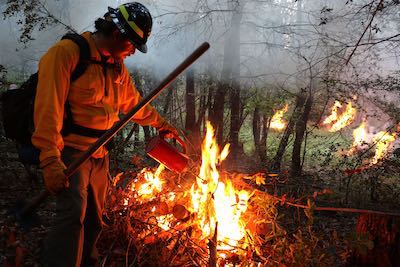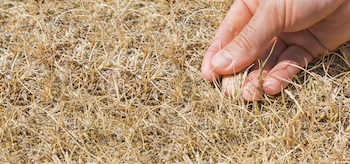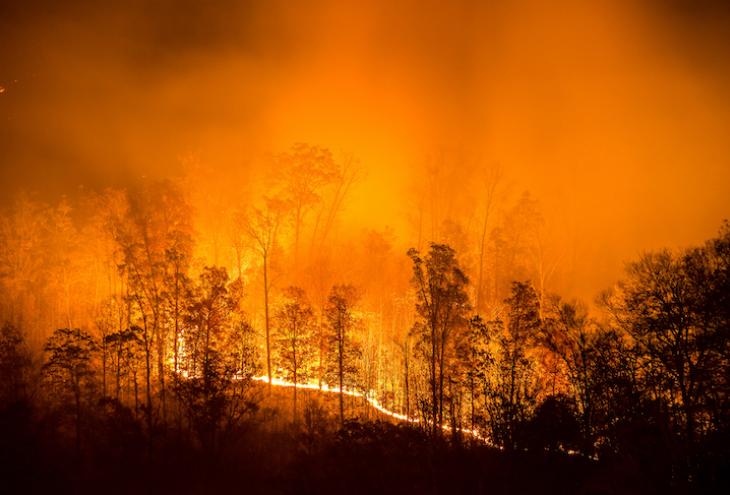Indigenous people have long planned for the seasons. Whether storing food for winter, burning strategically to clear debris and ensure continued habitat for both wildlife and humans, or migrating between winter and summer camps, Native people think — and plan — ahead.
In contemporary days, though, tribal governments and communities are also thinking about, and planning for, events that may never happen, but which have the potential to greatly disrupt their lands and peoples. They’re preparing for natural disasters, prolonged drought, and other possible consequences of climate change using both traditional methods and 21st-century technology.
Anticipating Wildfires
In the forests, deep river canyons, and rugged mountains of Northwestern California, the Karuk Tribe has stewarded its 1.48 million-acre ancestral land in the Klamath River Basin for millennia. Their way of life, including cultural burning, watershed protection, and plant husbandry, was disrupted when California became a state in 1848. But in recent years, the Karuk and other tribes in the area have recommenced their traditional roles as cultural stewards — and that includes prescribed burning, which among other environmental benefits mitigates the magnitude and destructiveness of wildfires that threaten this fire-adapted land.
“The tribe and local watershed groups have been working for decades on stream and water quality,” says Bill Tripp of the Karuk Tribe Department of Natural Resources. “Six Rivers National Forest, the tribe, and watershed councils sat down and determined we’re going to work together.” That commitment to ensuring a healthy ecosystem resulted in the creation of the Western Klamath Restoration Partnership (WKRP). Joined by local community Fire Safe Councils, the partnership is returning the land to the healthy, biodiverse ecosystem that once provided abundant food and habitat for animals, plants, and humans. Culturally significant plants such as huckleberry, oak, and hazel are carefully nurtured. Watersheds are being cleaned up.

to prevent wildfires.
The partnership is working to burn more land to save it from the deadly wildfires that have wreaked havoc in California over the past decade. So far, the partnership has treated more than 5,500 acres around neighborhoods. “Our big plan is to use traditional ecological knowledge (TEK) to build ecological resilience,” says Tripp.
In addition, WKRP is part of prescribed fire training exchanges, or TREX, an interdisciplinary model that incorporates tribal, public, and private entities. It also furnishes burning models that help build capacity that fits a community or region, whether for preventive burning or fighting wildfires. In Karuk’s case, incorporating TEK into the TREX model ensures that tribal practices are part of the program.
The partnership also makes use of technology, collecting data on iPads with special software. “One of the first things we invested in was our data processing capabilities, and one of our hires was a GIS specialist and data steward,” says Tripp. “And we started using drones during TREX exercises.”
The tribe publishes its climate adaptation plan at karuktribeclimatechangeprojects.com, a site that includes information on how Karuk is preparing not only for wildfires but also floods and landslides.
Preparing for Drought
 The Karuk Tribe is far from the only California community preparing for disasters — Southern California tribes are getting ready not only for wildfires but also long-term water crises. In the Pauma Valley in northern San Diego County, periodic water shortages are a way of life for the five tribes that call this semi-arid valley home. But tribes here are now preparing for a different scenario: drought.
The Karuk Tribe is far from the only California community preparing for disasters — Southern California tribes are getting ready not only for wildfires but also long-term water crises. In the Pauma Valley in northern San Diego County, periodic water shortages are a way of life for the five tribes that call this semi-arid valley home. But tribes here are now preparing for a different scenario: drought.
The San Pasqual Band of Mission Indians is a community of about 2,400 Kumeyaay citizens, most of whom live on the reservation. The tribe’s land base is discontinuous, which creates a challenge for infrastructure. But managing water shortages brought on by California’s historic seven-year drought was even more of a challenge. “Water is life, but it’s in short supply and high demand,” says John Flores, a public works manager with the tribe. “Even if we had it to waste, I don’t want to waste it.”
As the region grows hotter and drier, saving water is more important than ever, and the San Pasqual tribe has developed a series of water-conserving measures, like charging residents for water. Leaks also take a toll on both checkbooks and available supply in this community, which, as Flores says, is always fearful of running dry. The tribal water system now offers an app so customers can monitor water use — if they notice unusually high usage, the problem can be fixed fast. The tribal water department also encourages reservation residents to avoid using bleach and hard detergents, which impair the biological functions of septic tanks and eventually affect the aquifers.
What’s more, the tribe has also moved toward reusing existing water — gray water — from the tribe’s Valley View Casino as well as from homes. San Pasqual supplies its fire department with the reclaimed water via distinctive purple hydrants.
Girding with Green Energy
Solar power isn’t usually thought of as a disaster preparedness tool, but one Lakota business owner in South Dakota is building not only preparedness systems but also resilience and economic opportunity in his community. Lakota Solar Enterprises was founded by Henry Red Cloud in 2006 to help his community, the Oglala Lakota Nation, return to ancestral self-reliance. “I came home and realized I missed my culture, my language, dances, and ceremony,” says Red Cloud. But, he adds, “I couldn’t get a house or work.” So Red Cloud started his own company, Lakota Solar.
 The firm installs solar power systems and constructs solar-powered home heating units that can save a family up to 25 percent on their power bill — a boon during the harsh South Dakota winters. The company also trains tribal members to become solar power installers, building capacity throughout the Northern Plains. And Red Cloud created a training facility that teaches tribal members how to build, install, and maintain off-the-grid power systems, solar-powered water pumps and filtration systems, and other sustainable utility services. “We’re getting our students excited about creating their own businesses,” says Red Cloud.
The firm installs solar power systems and constructs solar-powered home heating units that can save a family up to 25 percent on their power bill — a boon during the harsh South Dakota winters. The company also trains tribal members to become solar power installers, building capacity throughout the Northern Plains. And Red Cloud created a training facility that teaches tribal members how to build, install, and maintain off-the-grid power systems, solar-powered water pumps and filtration systems, and other sustainable utility services. “We’re getting our students excited about creating their own businesses,” says Red Cloud.
But it’s the mobile solar power units that make Lakota Solar Enterprises stand out as a disaster preparedness tool that any family can manage. The 5kW units can easily be transported to wherever power is needed. “We loan the mobile plants out to various organizations,” he says. Red Cloud’s firm is building more power plants that can be deployed to keep the lights on during power outages and other emergencies.
Whether it’s being ready for short-term emergencies or long-term climatic changes, tribes and tribal entrepreneurs are leading the way in preparing their communities, their lands, and themselves for whatever may come their way.













